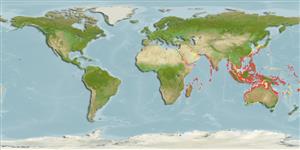Common names from other countries
Environment: milieu / climate zone / depth range / distribution range
Écologie
; profondeur 1 - 37 m (Ref. 100968). Tropical
Distribution
Pays | Zones FAO | Écosystèmes | Occurrences | Introductions
Indo-West Pacific: from central East Africa, to Sri Lanka; from Andaman and Nicobar Islands to eastern Melanesia; north to Japan and south to Queensland and New Caledonia.
Length at first maturity / Taille / Poids / Âge
Maturity: Lm ? range ? - ? cm Max length : 5.0 cm SHL mâle / non sexé; (Ref. 349); common length : 4.0 cm SHL mâle / non sexé; (Ref. 349)
Mainly collected for shellcraft, where the species is abundant (Ref. 349). Found on shallow waters, on weeds and sand (Ref. 799). Also occurs in shallow subtidal waters (Ref. 349).
Life cycle and mating behavior
Maturité | Reproduction | Frai | Œufs | Fécondité | Larves
Members of the order Neotaenioglossa are mostly gonochoric and broadcast spawners. Life cycle: Embryos develop into planktonic trocophore larvae and later into juvenile veligers before becoming fully grown adults.
Poutiers, J.M. 1998. (Ref. 349)
Statut dans la liste rouge de l'IUCN (Ref. 130435)
statut CITES (Ref. 108899)
Not Evaluated
Not Evaluated
Menace pour l'homme
Harmless
Utilisations par l'homme
| FishSource |
Outils
Plus d'informations
Taille/ÂgeCroissanceLongueur-poidsLongueur-longueurMorphologieLarvesAbondance
Sources Internet
Estimates based on models
Preferred temperature
(Ref.
115969): 24.7 - 29.1, mean 28.2 (based on 1088 cells).
Vulnérabilité
Low vulnerability (10 of 100).
